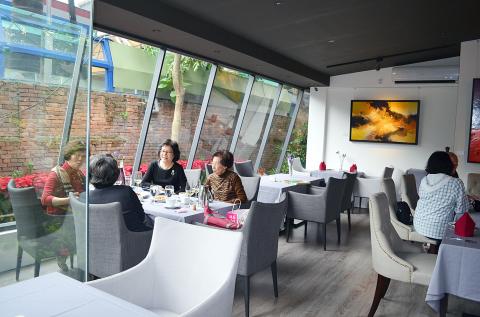In a city with a rich, diverse past like Taipei, serendipity comes in many ways. Tom Chen (陳登壽) owns Jimmy’s Kitchen, a famous Shanghai restaurant with its own history — one that included the original owner fleeing to Taiwan from Shanghai in 1949. But Chen always had another dream.
Chen began work in the service industry at the Grand Hotel, which sent him to Lubeck, Germany to learn bar tending. While there, he became fascinated with the vibrant, raucous atmosphere of salons — places where artists, writers and academics would meet and discuss art and other topics. Chen’s dream was to bring that experience back to Taiwan.
Enter Wolfgang Kroll (1906-1992), a Professor Emeritus in Physics at National Taiwan University (NTU) who grew up in Germany at the height of the Art Deco period. Kroll held the belief that art, literature and science should interrelate.

Photo: Jerome Keating
Kroll may not be a household name with most Taipei residents, but he is well known in the medical and science community because he helped draw international attention to the university, and was responsible for teaching theoretical physics as well as German to generations of physicists and future doctors even after his official retirement.
Kroll, who studied quantum mechanics in Germany under Nobel Prize-winning physicist Werner Heisenberg, emigrated from his home country after Hitler and the Nazi party came to power because one grandparent had Jewish ancestry. With a fascination for Japanese language and culture, Kroll went to Japan in 1937, and then, in 1941, its then-colony Taiwan. One of Kroll’s research papers became the first paper from Taiwan to be published in an international journal.
Until his death in 1992, Kroll lived for half a century in a small Japanese-style house belonging to the university. After his death, the building returned to NTU, which offered it up for development. Still nurturing the dream of a salon, Chen, along with his artist and interior designer-friend Tsai Wen-hsiung (蔡文雄), signed a seven-year lease with the university with an option for renewal. Six months later, the split-level, upscale salon with plenty of natural lighting and artwork, opened to the public as Jimmy’s Garden.
Not strictly a gallery, though art is everywhere, or a restaurant, though you can go there for a meal as well as teatime, Jimmy’s Garden tries to replicate the ambiance of a salon, where he hopes that a new generation of artists, academics and intellectuals will come together over a glass of wine or cup of coffee to discuss and debate current events.
Artists are encouraged to submit an application to display their work at Jimmy’s Garden. Yu Lien-chun’s (余連春) terracotta and metal sculptures are on display until Jan. 31. The salon is open daily from 11am to 9pm and closed on Mondays. 5, Ln 11, Xinsheng S Rd, Sec 3, Taipei City (台北市新生南路三段11巷5號); tel: (02) 2368-1197.

Taiwan can often feel woefully behind on global trends, from fashion to food, and influences can sometimes feel like the last on the metaphorical bandwagon. In the West, suddenly every burger is being smashed and honey has become “hot” and we’re all drinking orange wine. But it took a good while for a smash burger in Taipei to come across my radar. For the uninitiated, a smash burger is, well, a normal burger patty but smashed flat. Originally, I didn’t understand. Surely the best part of a burger is the thick patty with all the juiciness of the beef, the

The ultimate goal of the Chinese Communist Party (CCP) is the total and overwhelming domination of everything within the sphere of what it considers China and deems as theirs. All decision-making by the CCP must be understood through that lens. Any decision made is to entrench — or ideally expand that power. They are fiercely hostile to anything that weakens or compromises their control of “China.” By design, they will stop at nothing to ensure that there is no distinction between the CCP and the Chinese nation, people, culture, civilization, religion, economy, property, military or government — they are all subsidiary

This year’s Miss Universe in Thailand has been marred by ugly drama, with allegations of an insult to a beauty queen’s intellect, a walkout by pageant contestants and a tearful tantrum by the host. More than 120 women from across the world have gathered in Thailand, vying to be crowned Miss Universe in a contest considered one of the “big four” of global beauty pageants. But the runup has been dominated by the off-stage antics of the coiffed contestants and their Thai hosts, escalating into a feminist firestorm drawing the attention of Mexico’s president. On Tuesday, Mexican delegate Fatima Bosch staged a

Nov.10 to Nov.16 As he moved a large stone that had fallen from a truck near his field, 65-year-old Lin Yuan (林淵) felt a sudden urge. He fetched his tools and began to carve. The recently retired farmer had been feeling restless after a lifetime of hard labor in Yuchi Township (魚池), Nantou County. His first piece, Stone Fairy Maiden (石仙姑), completed in 1977, was reportedly a representation of his late wife. This version of how Lin began his late-life art career is recorded in Nantou County historian Teng Hsiang-yang’s (鄧相揚) 2009 biography of him. His expressive work eventually caught the attention